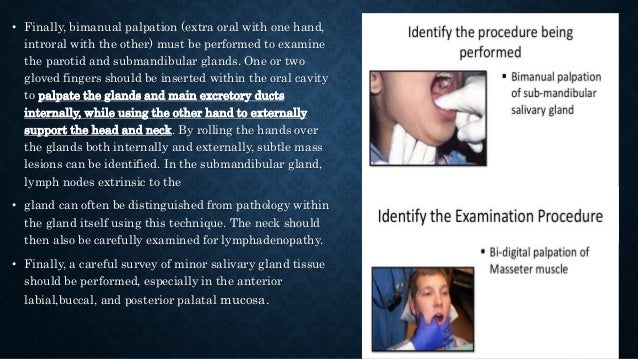Bimanual Examination Of The Parotid Gland

Specialized Fsr Xc 2006 Manual. Bimanual palpation is useful in differentiating submandibular salivary gland swellings from enlarged submandibular lymph nodes. Parotid neoplasm is observed as a diffuse swelling in front of the ear or over the angle of the jaw, often lifting the ear lobule (figure 18A and figure 18B). Case Reports in Dentistry is a. Although not as frequent as sialadenitis of the parotid gland. Clinical examination revealed that spherical shape swelling.
Abstract BACKGROUND: To the authors' knowledge, the indications for adjuvant treatment in acinic cell carcinoma (AciCC) of the parotid gland have not been elucidated to date. The aim of the current study was to determine patterns of failure and adverse prognostic features. Kpg 49d 4 20 Music. METHODS: Between March of 1989 and August of 2006, 35 patients underwent surgery at Memorial Sloan-Kettering Cancer Center for AciCC of the parotid gland and had their clinical and pathologic features retrospectively analyzed at the primary site.
All cases were reviewed by 2 head and neck pathologists. Five-year estimates of survival outcomes were performed, followed by univariate analysis of potential prognostic features.
RESULTS: The T classifications were as follows: T1 in 46% of patients, T2 in 23% of patients, T3 in 18% of patients, and T4 in 9% of patients. Three patients had cervical lymph node involvement. All patients underwent surgery as their primary treatment. Approximately 63% of patients (n = 22) received radiation treatment. The median follow-up time for surviving patients was 59.9 months. Five-year estimates of disease-free survival (DFS), overall survival (OS), and local control were 85%, 90%, and 90%, respectively.
Killing Floor Map Pack V2. Of the clinical variables tested, clinical extracapsular extension (ECE), facial nerve sacrifice, and lymph node involvement were found to be significantly associated with a detriment in DFS and OS ( P 2 mitoses per 10 high-power fields (HPF), atypical mitosis, vascular invasion, perineural invasion, pleomorphism, and necrosis were associated with adverse DFS ( P 2 mitoses/10 HPF) and/or tumor necrosis, high-grade carcinomas had a significantly lower DFS and OS ( P =.001). CONCLUSIONS: AciCC had a low treatment failure rate, and a large number of patients could be considered candidates for surgery only. A histologic grading system was devised to help stratify patients for adjuvant treatment. © 2009 American Cancer Society. • • Acinic cell carcinoma (AciCC) of the major salivary glands is a rare clinical entity, comprising approximately 10% of salivary gland tumors. In contrast to other salivary gland malignancies, the disease often follows a less aggressive course. Although surgery is the standard approach, to our knowledge indications for postoperative treatment have not been established to date.
This issue is particularly relevant because the disease often presents in younger patients, when long-term toxicities are more pertinent. Due to the rarity of the disease, prior data regarding clinical characteristics and treatment outcomes have been confined largely to case reports and retrospective series, in which the role of radiation and chemotherapy has not clearly been established. These studies often span several decades and involve multiple treating institutions, such that treatment techniques vary widely among patients and therefore conclusions regarding management are difficult to draw. In addition, to our knowledge there have been only a few prior studies examining the histologic prognostic features of AciCC. Therefore, the goals of the current study were 2-fold. First, we present a recent experience of this disease at our institution, including control and survival outcomes, during which time consistent treatment paradigms were used to aid in treatment decisions.